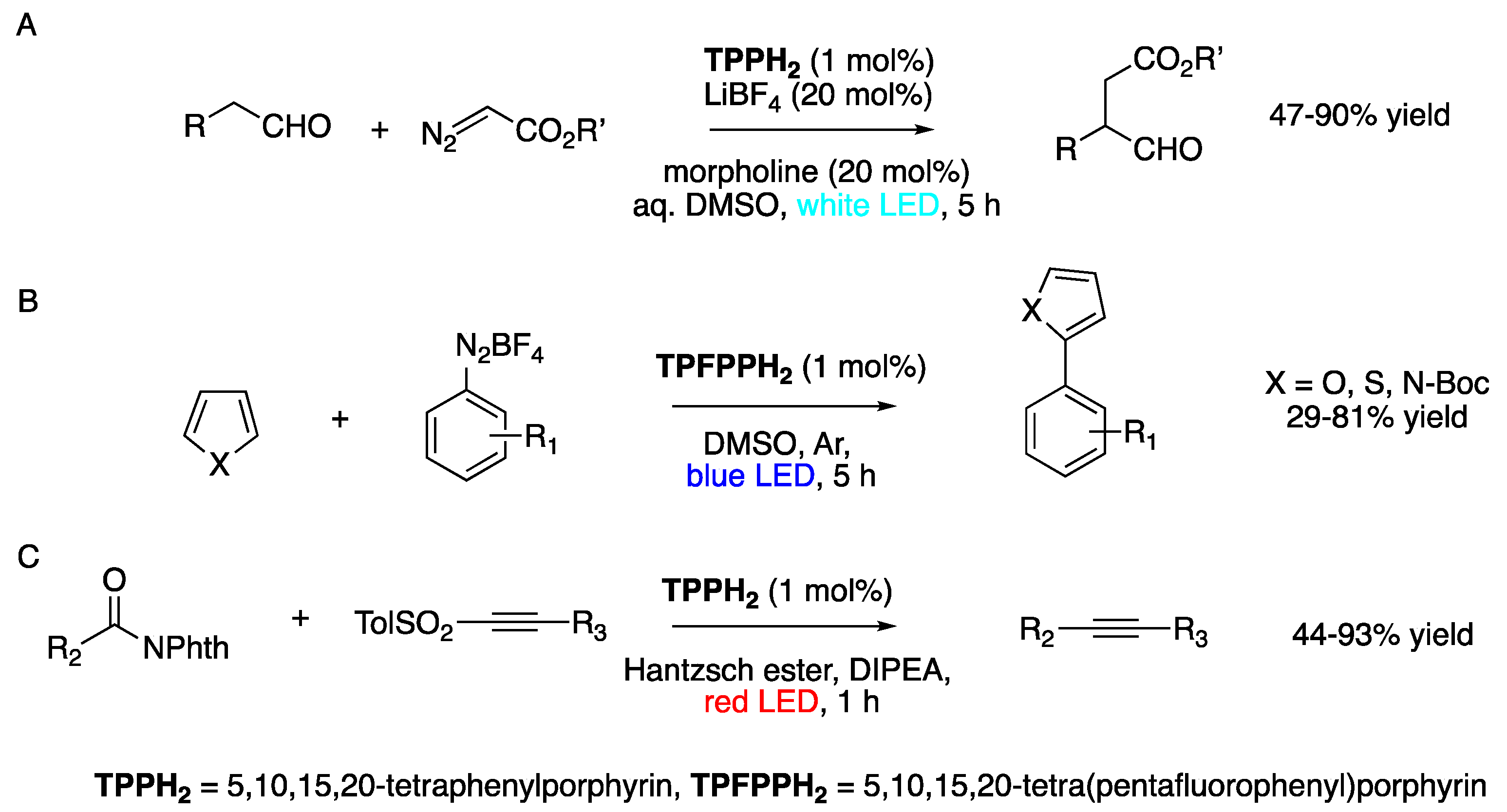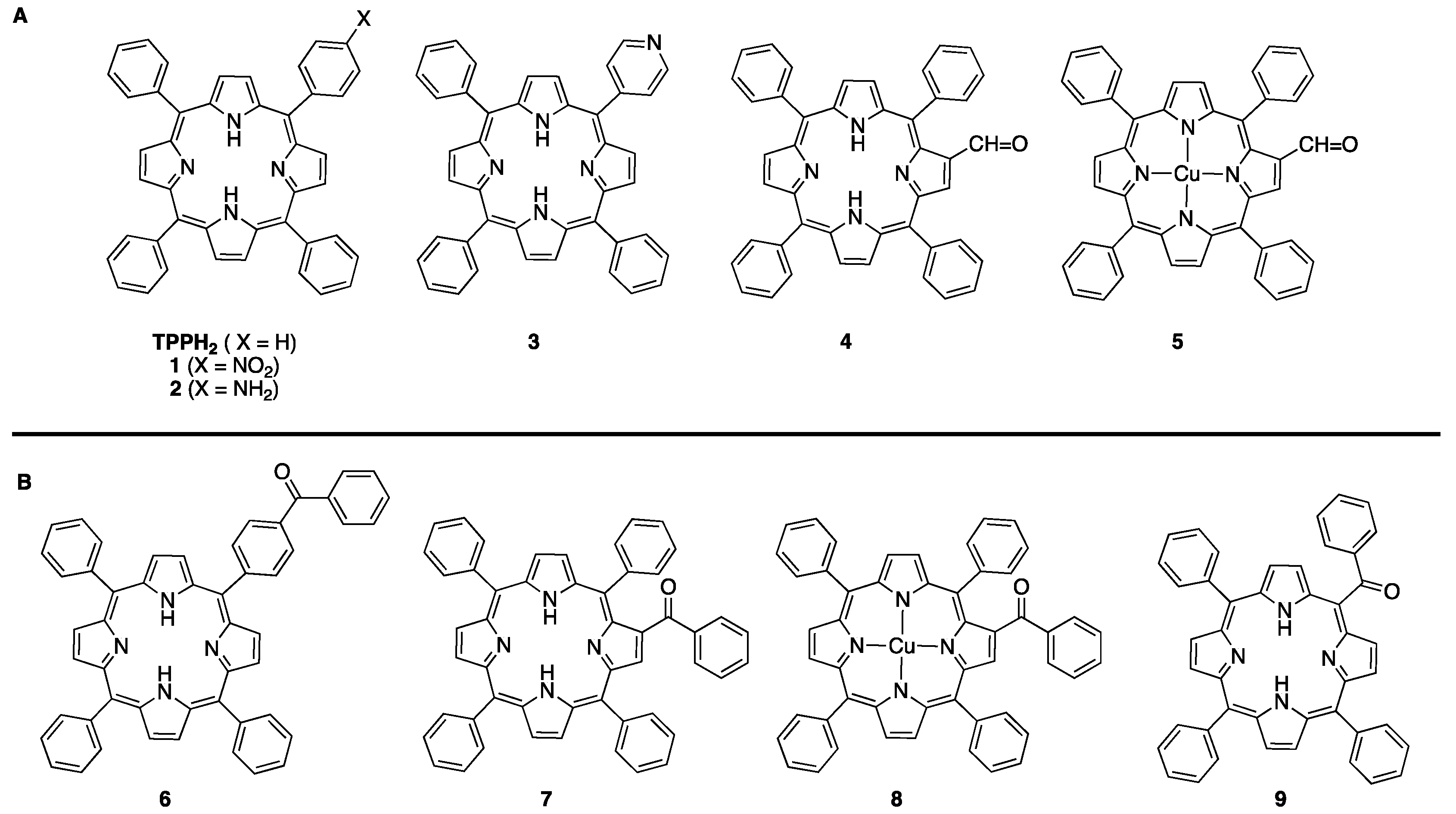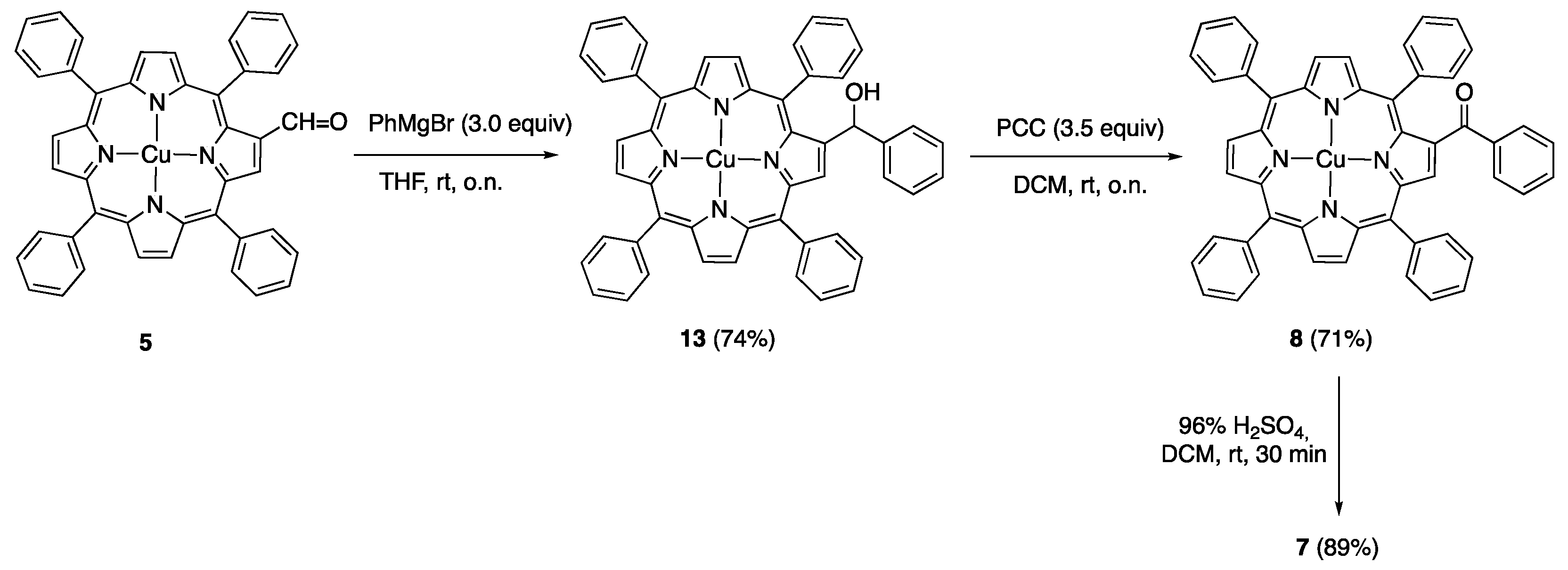Substituent Effects in the Photophysical and Electrochemical Properties of Meso-Tetraphenylporphyrin Derivatives
Abstract
1. Introduction
2. Results and Discussion
3. Materials and Methods
3.1. General Methods
3.2. Photophysical Methods
3.3. Cyclic Voltammetry
3.4. Synthetic Procedures and Product Characterization
4. Conclusions
Supplementary Materials
Author Contributions
Funding
Institutional Review Board Statement
Informed Consent Statement
Data Availability Statement
Acknowledgments
Conflicts of Interest
References
- Nicewicz, D.A.; MacMillan, D.W.C. Merging photoredox catalysis with organocatalysis. Science 2008, 322, 77–80. [Google Scholar] [CrossRef] [PubMed]
- Ischay, M.A.; Anzovino, M.E.; Du, J.; Yoon, T.P. Efficient Visible Light Photocatalysis of [2+2] Enone Cycloadditions. J. Am. Chem. Soc. 2008, 130, 12886–12887. [Google Scholar] [CrossRef] [PubMed]
- Narayanam, J.M.R.; Tucker, J.W.; Stephenson, C.R. Electron-Transfer Photoredox Catalysis: Development of a Tin-Free Reductive Dehalogenation Reaction. J. Am. Chem. Soc. 2009, 131, 8756–8757. [Google Scholar] [CrossRef] [PubMed]
- Narayanam, J.W.; Stephenson, C.R. Visible light photoredox catalysis: Applications in organic synthesis. Chem. Soc. Rev. 2011, 40, 102–113. [Google Scholar] [CrossRef] [PubMed]
- Prier, C.K.; Rankic, D.A.; MacMillan, D.W.C. Visible light photoredox catalysis with transition metal complexes: Applications in organic synthesis. Chem. Rev. 2013, 113, 5322–5363. [Google Scholar] [CrossRef] [PubMed]
- Tucker, J.W.; Stephenson, C.R.J. Shining Light on Photoredox Catalysis: Theory and Synthetic Applications. J. Org. Chem. 2012, 77, 1617–1622. [Google Scholar] [CrossRef] [PubMed]
- Striet-Kalthoff, F.; James, M.J.; Teders, M.; Pitzer, L.; Glorius, F. Energy transfer catalysis mediated by visible-light: Principles, applications, directions. Chem. Soc. Rev. 2018, 47, 7190–7202. [Google Scholar] [CrossRef] [PubMed]
- Rigotti, T.; Alemán, J. Visible light photocatalysis—From racemic to asymmetric activation strategies. Chem. Commun. 2020, 56, 11169–11190. [Google Scholar] [CrossRef]
- Cauwenbergh, R.; Das, S. Photocatalysis. A Green Tool for Redox Reactions. Synlett 2022, 33, 129–149. [Google Scholar] [CrossRef]
- Wu, Y.; Kim, D.; Teets, T.S. Photophysical Properties and Redox Potentials of Photosensitizers for Organic Photoredox Transformations. Synlett 2022, 33, 1154–1179. [Google Scholar] [CrossRef]
- Campestrini, S.; Tonellato, U. Photoinitiated Olefin Epoxidation with Molecular Oxygen, Sensitized by Free Base Porphyrins and Promoted by Hexacarbonylmolybdenum in Homogeneous Solution. Eur. J. Org. Chem. 2002, 2002, 3827–3832. [Google Scholar] [CrossRef]
- Clennan, E.L.; Pace, A. Advances in singlet oxygen chemistry. Tetrahedron 2005, 61, 6665–6691. [Google Scholar] [CrossRef]
- Chen, J.-J.; Hong, G.; Gao, L.-J.; Liu, T.-J.; Cao, W.-J. In vitro and in vivo antitumor activity of a novel porphyrin-based photosensitizer for photodynamic therapy. J. Cancer Res. Clin. Oncol. 2015, 141, 1553–1561. [Google Scholar] [CrossRef] [PubMed]
- Rostami, M.; Rafiee, L.; Hassanzadeh, F.; Dadrass, A.R.; Khodarahmi, G.A. Synthesis of some new porphyrins and their metalloderivatives as potential sensitizers in photo-dynamic therapy. Res. Pharm. Sci. 2015, 10, 504–513. [Google Scholar] [PubMed] [PubMed Central]
- Rybicka-Jasinska, K.; Shan, W.; Zawada, K.; Kadish, K.M.; Gryko, D. Porphyrins as Photoredox Catalysts: Experimental and Theoretical Studies. J. Am. Chem. Soc. 2016, 138, 15451–15458. [Google Scholar] [CrossRef] [PubMed]
- Costa e Silva, R.; da Silva, L.O.; Bartolomeu, A.A.; Brocksom, T.J.; de Oliveira, K.T. Recent applications of porphyrins as photocatalysts in organic synthesis: Batch and continuous flow approaches. Beilstein, J. Org. Chem. 2020, 16, 917–955. [Google Scholar] [CrossRef]
- Rybicka-Jasinska, K.; Wdowik, T.; Luczak, K.; Wierzba, A.J.; Drapala, O.; Gryko, D. Porphyrins as Promising Photocatalysts for Red-Light-Induced Functionalizations of Biomolecules. ACS Org. Inorg. Au 2022, 2, 422–426. [Google Scholar] [CrossRef]
- Arlegui, A.; El-Hachemi, Z.; Crusats, J.; Moyano, A. 5-Phenyl-10,15,20-Tris(4-sulfonatophenyl)porphyrin: Synthesis, Catalysis, and Structural Studies. Molecules 2018, 23, 3363. [Google Scholar] [CrossRef]
- Arlegui, A.; Soler, B.; Galindo, A.; Arteaga, O.; Canillas, A.; Ribó, J.M.; El-Hachemi, Z.; Crusats, J.; Moyano, A. Spontaneous mirror-symmetry breaking coupled to top-bottom chirality transfer: From porphyrin self-assembly to scalemic Diels–Alder adducts. Chem. Commun. 2019, 55, 12219–12222. [Google Scholar] [CrossRef]
- Arlegui, A.; Torres, P.; Cuesta, V.; Crusats, J.; Moyano, A. A pH-Switchable Aqueous Organocatalysis with Amphiphilic Secondary Amine–Porphyrin Hybrids. Eur. J. Org. Chem. 2020, 2020, 4399–4407. [Google Scholar] [CrossRef]
- Arlegui, A.; Torres, P.; Cuesta, V.; Crusats, J.; Moyano, A. Chiral Amphiphilic Secondary Amine-Porphyrin Hybrids for Aqueous Organocatalysis. Molecules 2020, 25, 3420. [Google Scholar] [CrossRef]
- Torres, P.; Guillén, M.; Escribà, M.; Crusats, J.; Moyano, A. Synthesis of New Amino-Functionalized Porphyrins: Preliminary Study of Their Organophotocatalytic Activity. Molecules 2023, 28, 1997. [Google Scholar] [CrossRef]
- Kadish, K.M.; Cornillon, J.-L.; Yao, C.-L.; Malinski, T.; Gritzner, G. Solvent effects on electrode potentials of metalloporphyrins. Reduction of 5,10,15,20-tetraphenylporphinato complexes in non-aqueous media. J. Electroanal. Chem. 1987, 235, 189–207. [Google Scholar] [CrossRef]
- Mandal, T.; Das, S.; De Sarkar, S. Nickel(II) Tetraphenylporphyrin as an Efficient Photocatalyst Featuring Visible Light Promoted Dual Redox Reactions. Adv. Synth. Catal. 2019, 361, 3200–3209. [Google Scholar] [CrossRef]
- Bhyrappa, P.; Sankar, M.; Varghese, B. Mixed Substituted Porphyrins: Structural and Electrochemical Redox Properties. Inorg. Chem. 2006, 45, 4136–4149. [Google Scholar] [CrossRef] [PubMed]
- Fang, Y.; Jiang, X.; Ou, Z.; Michelin, C.; Desbois, N.; Gros, C.P.; Kadish, K.M. Redox properties of nitrophenylporphyrins and electrosynthesis of nitrophenyl-linked Zn porphyrin dimers or arrays. J. Porphyr. Phthalocyanines 2014, 18, 832–841. [Google Scholar] [CrossRef]
- Adler, A.D.; Longo, F.R.; Finarelli, J.D.; Goldmacher, J.; Assour, J.; Korsakoff, L. A simplified synthesis for meso-tetraphenylporphine. J. Org. Chem. 1967, 32, 476. [Google Scholar] [CrossRef]
- Wagner, R.W.; Lawrence, D.S.; Lindsey, J.S. An improved synthesis of tetramesitylporphyrin. Tetrahedron Lett. 1987, 28, 3069–3070. [Google Scholar] [CrossRef]
- Lindsey, J.S.; Prathapan, S.; Johnson, T.E.; Wagner, R.W. Porphyrin Building Blocks for Modular Construction of Bioorganic Model Systems. Tetrahedron 1994, 50, 8941–8968. [Google Scholar] [CrossRef]
- Gadde, K.; De Vos, D.; Maes, B.U.W. Basic Concepts and Activation Modes in Visible-Light Photocatalyzed Organic Synthesis. Synthesis 2023, 55, 164–192. [Google Scholar] [CrossRef]
- Seely, G.R. The energetics of electron-transfer reactions of chlorophyll and other compounds. Photochem. Photobiol. 1978, 27, 639–654. [Google Scholar] [CrossRef]
- Rillema, D.P.; Nagle, J.K.; Barringer, L.F., Jr.; Meyer, T.J. Redox Properties of Metalloporphyrin Excited States, Lifetimes, and Related Properties of a Series of Para-Substituted Tetraphenylporphine Carbonyl Complexes of Rutenium(II). J. Am. Chem. Soc. 1981, 103, 56–62. [Google Scholar] [CrossRef]
- Capaldo, C.; Ravelli, D.; Fagnoni, M. Direct Photocatalyzed Hydrogen Atom Transfer (HAT) for Aliphatic C–H Bonds Elaboration. Chem. Rev. 2022, 122, 1875–1924. [Google Scholar] [CrossRef] [PubMed]
- Bonfantini, E.E.; Burrell, A.K.; Campbell, W.M.; Crossley, M.J.; Gosper, J.J.; Harding, M.M.; Officer, D.L.; Reid, D.C.W. Efficient synthesis of free-base 2-formyl-5,10,15,20-tetraarylporphyrins, their reduction and conversion to [(porphyrin-2-yl)methyl]phosphonium salts. J. Porphyr. Phthalocyanines 2002, 6, 708–719. [Google Scholar] [CrossRef]
- Richeter, S.; Jeandon, C.; Gisselbrecht, J.-P.; Ruppert, R.; Callot, H. Synthesis and Optical and Electrochemical Properties of Porphyrin Dimers Linked by Metal Ions. J. Am. Chem. Soc. 2002, 124, 6168–6179. [Google Scholar] [CrossRef]
- Lower, S.K.; El-Sayed, M.A. The triplet state and molecular electronic processes in organic molecules. Chem. Rev. 1966, 66, 199–241. [Google Scholar] [CrossRef]






| Entry | Porphyrin | Experimental Ground-State Redox Half-Wave Potentials (V vs. SCE) | |||
|---|---|---|---|---|---|
| [PC−/PC2−] | [PC/PC−] | [PC+/PC] | [PC2+/PC+] | ||
| 1 | TPPH2 a | −1.63 | −1.21 | +1.09 | +1.28 |
| 2 | 1 b | −1.66 c | −1.21 d/−1.06 e | +1.10 f | +1.20 f |
| 3 | 2 | −1.56 | −1.22 | +1.00 f,g/+1.10 f | +1.70 f |
| 4 | 3 | −1.49 | −1.14 | +1.05 f,h/+1.15 | +1.60 f |
| 5 | 4 | −1.23 | −0.95 | +1.11 | +1.45 |
| 6 | 5 | −1.43 | −1.07 | +1.11 | +1.48 |
| 7 | 6 | −1.37 | −1.10 | +1.24 | +1.56 |
| 8 | 7 | −1.28 | −1.00 | +1.22 | +1.43 |
| 9 | 8 | −1.31 | −1.09 | +1.23 | +1.60 |
| 10 | 9 | −1.17 | −0.97 | +1.32 | +1.62 |
| Entry | Porphyrin | Ground-State Redox Potentials (V vs. SCE) | (Singlet) Excited-State Redox Potentials (V vs. SCE) | ||
|---|---|---|---|---|---|
| [PC/PC−] | [PC+/PC] | [*PC/PC−] | [PC+/*PC] | ||
| 1 | TPPH2 a | −1.21 | +1.09 | +0.70 | −0.82 |
| 2 | 1 | −1.06 | +1.10 | +0.85 | −0.81 |
| 3 | 2 | −1.22 | +1.00 | +0.69 | −0.91 |
| 4 | 3 | −1.14 | +1.05 | +0.77 | −0.86 |
| 5 | 4 | −0.95 | +1.11 | +0.91 | −0.80 |
| 6 | 5 | −1.07 | +1.11 | +0.93 | −0.90 |
| 7 | 6 | −1.10 | +1.24 | +0.81 | −0.71 |
| 8 | 7 | −1.00 | +1.22 | +0.89 | −0.67 |
| 9 | 8 | −1.09 | +1.23 | +0.91 | −0.77 |
| 10 | 9 | −0.97 | +1.32 | +0.94 | −0.59 |
| Porphyrin | Less Energetic Absorption Q Band (nm) | More Energetic Emission Q(0,0) Band (nm) | Normalized Intersection Wavelength (nm) | Relative Fluorescence Quantum Yield (ϕf) a | Estimated Singlet Excited-State Energies (V) |
|---|---|---|---|---|---|
| 6 | 645 | 651 | 648 | 0.09 | 1.91 |
| 7 | 651 | 662 | 657 | 0.09 | 1.89 |
| 8 | 587 | 650 | 618 | 0.002 | 2.00 |
| 9 | 647 | 650 | 648 | 0.08 | 1.91 |
Disclaimer/Publisher’s Note: The statements, opinions and data contained in all publications are solely those of the individual author(s) and contributor(s) and not of MDPI and/or the editor(s). MDPI and/or the editor(s) disclaim responsibility for any injury to people or property resulting from any ideas, methods, instructions or products referred to in the content. |
© 2024 by the authors. Licensee MDPI, Basel, Switzerland. This article is an open access article distributed under the terms and conditions of the Creative Commons Attribution (CC BY) license (https://creativecommons.org/licenses/by/4.0/).
Share and Cite
Millheim, A.C.; Ponzano, E.; Moyano, A. Substituent Effects in the Photophysical and Electrochemical Properties of Meso-Tetraphenylporphyrin Derivatives. Molecules 2024, 29, 3689. https://doi.org/10.3390/molecules29153689
Millheim AC, Ponzano E, Moyano A. Substituent Effects in the Photophysical and Electrochemical Properties of Meso-Tetraphenylporphyrin Derivatives. Molecules. 2024; 29(15):3689. https://doi.org/10.3390/molecules29153689
Chicago/Turabian StyleMillheim, Alexandra Cruz, Enric Ponzano, and Albert Moyano. 2024. "Substituent Effects in the Photophysical and Electrochemical Properties of Meso-Tetraphenylporphyrin Derivatives" Molecules 29, no. 15: 3689. https://doi.org/10.3390/molecules29153689
APA StyleMillheim, A. C., Ponzano, E., & Moyano, A. (2024). Substituent Effects in the Photophysical and Electrochemical Properties of Meso-Tetraphenylporphyrin Derivatives. Molecules, 29(15), 3689. https://doi.org/10.3390/molecules29153689









